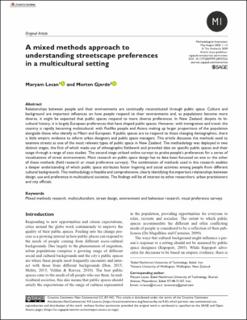| dc.description.abstract | Relationships between people and their environments are continually reconstituted through public space. Culture and background are important influences on how people respond to their environments and, as populations become more diverse, it might be expected that public spaces respond to more diverse preferences. In New Zealand, despite its bi-cultural history, it is largely European preferences that have shaped public spaces. However, with immigration and travel, the country is rapidly becoming multicultural, with Pasifika people and Asians making up larger proportions of the population alongside those who identify as Māori and European. If public spaces are to respond to these changing demographics, there is little empiric evidence to inform urban designers and public space managers. This article discusses the methods used to examine streets as one of the most relevant types of public space in New Zealand. The methodology was deployed in two distinct stages, the first of which made use of ethnographic fieldwork and provided data on specific public spaces and their usage through a range of case studies. The second stage utilised online surveys to probe people’s preferences for a series of visualisations of street environments. Most research on public space design has to date been focussed on one or the other of these methods (field research or visual preference surveys). The combination of methods used in this research enables a deeper understanding of which public space attributes foster lingering and social activities among people from different cultural backgrounds. This methodology is feasible and comprehensive, clearly identifying the important relationships between design, use and preference in multicultural societies. The findings will be of interest to other researchers, urban practitioners and city officials. | en_US |

